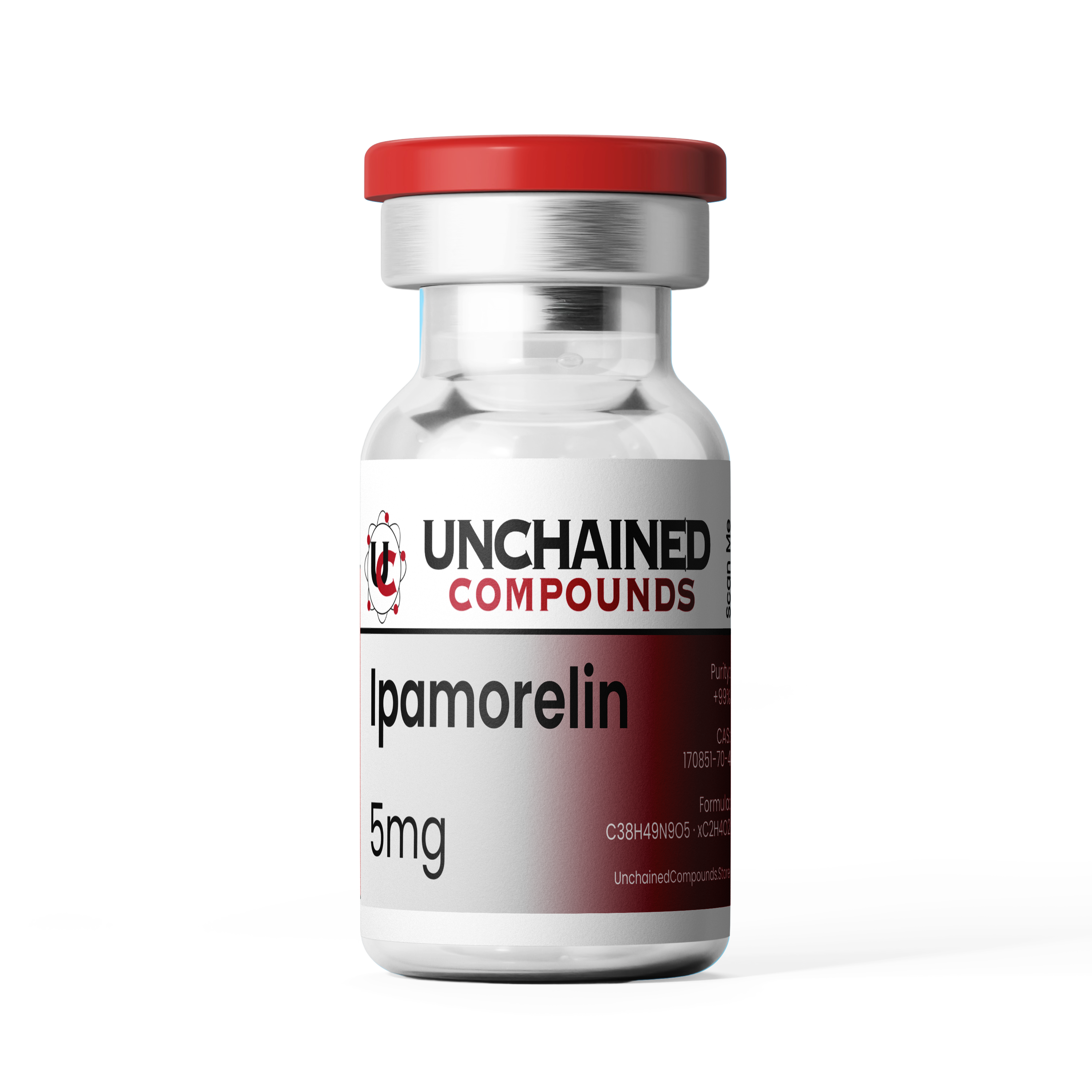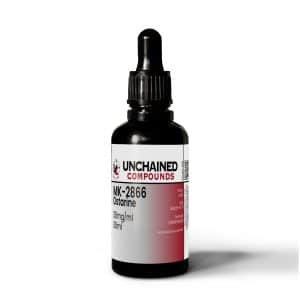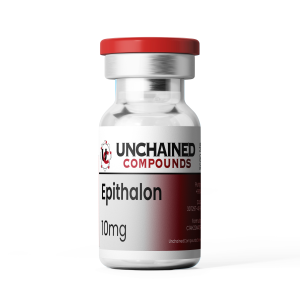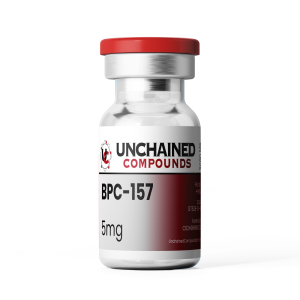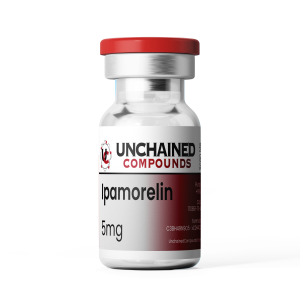Description






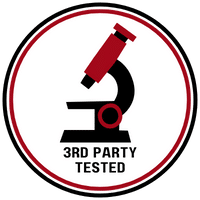
Ipamorelin is a synthetic peptide that is composed of five amino acids. It is a GH secretagogue, which means that it stimulates the production of growth hormone. Ipamorelin is also considered to be an agonist, which means that it binds to certain receptors of a cell and provokes a cellular response. The peptide’s operational mechanics enable it to stimulate the production of pituitary gland-based expression of secretions related to growth among animal test subjects. At the same time, the presence of the peptide has been shown to inhibit the production of a secretion known as somatostatin. Additionally, Ipamorelin has been shown to boost the production of IGF-1, or Insulin-like Growth Factor 1. The presence of IGF-1 plays a key role in the overall growth and repair of muscular and skeletal tissue.
Specifications
- Chemical Formula: C38H49N9O5
- Molecular Mass: 711.868g/mol
- Synonyms: AOD-9604; AOD 9604; AOD9604
- CAS Number: 170851-70-4
- PubChem: 9831659
- Total Amount of the Active Ingredient: 5 mg (1 vial)
- Shelf Life: 36 months
Research Studies
Ipamorelin, the first selective growth hormone secretagogue
Abstract
The development and pharmacology of a new potent growth hormone (GH) secretagogue, ipamorelin, is described. Ipamorelin is a pentapeptide (Aib-His-D-2-Nal-D-Phe-Lys-NH2), which displays high GH releasing potency and efficacy in vitro and in vivo. As an outcome of a major chemistry programme, ipamorelin was identified within a series of compounds lacking the central dipeptide Ala-Trp of growth hormone-releasing peptide (GHRP)-1. In vitro, ipamorelin released GH from primary rat pituitary cells with a potency and efficacy similar to GHRP-6 (ECs) = 1.3+/-0.4nmol/l and Emax = 85+/-5% vs 2.2+/-0.3nmol/l and 100%). A pharmacological profiling using GHRP and growth hormone-releasing hormone (GHRH) antagonists clearly demonstrated that ipamorelin, like GHRP-6, stimulates GH release via a GHRP-like receptor. In pentobarbital anaesthetised rats, ipamorelin released GH with a potency and efficacy comparable to GHRP-6 (ED50 = 80+/-42nmol/kg and Emax = 1545+/-250ng GH/ml vs 115+/-36nmol/kg and 1167+/-120ng GH/ml). In conscious swine, ipamorelin released GH with an ED50 = 2.3+/-0.03 nmol/kg and an Emax = 65+/-0.2 ng GH/ml plasma. Again, this was very similar to GHRP-6 (ED50 = 3.9+/-1.4 nmol/kg and Emax = 74+/-7ng GH/ml plasma). GHRP-2 displayed higher potency but lower efficacy (ED50 = 0.6 nmol/kg and Emax = 56+/-6 ng GH/ml plasma). The specificity for GH release was studied in swine. None of the GH secretagogues tested affected FSH, LH, PRL or TSH plasma levels. Administration of both GHRP-6 and GHRP-2 resulted in increased plasma levels of ACTH and cortisol. Very surprisingly, ipamorelin did not release ACTH or cortisol in levels significantly different from those observed following GHRH stimulation. This lack of effect on ACTH and cortisol plasma levels was evident even at doses more than 200-fold higher than the ED50 for GH release. In conclusion, ipamorelin is the first GHRP-receptor agonist with a selectivity for GH release similar to that displayed by GHRH. The specificity of ipamorelin makes this compound a very interesting candidate for future clinical development.
Abstract
Background: Delayed gastric emptying is a common disorder with few effective therapeutic options. The goal of this study was to investigate whether ipamorelin, a synthetic peptidomimetic that acts on the ghrelin receptor, accelerates gastric emptying in a rodent model of gastroparesis induced by abdominal surgery and intestinal manipulation.
Methods: Fasted adult male rats were subjected to laparotomy and intestinal manipulation. Following the surgery rats received ipamorelin (0.014–0.14 µmol/kg) or vehicle control via intravenous administration. Gastric emptying was measured by the percent of total recovered radioactivity remaining in the stomach 15 minutes after intragastric gavage of 1.5 mL of 99mTc (technicium-99m) sulfur colloid in 0.5% methylcellulose. In a separate group of rats subjected to laparotomy and intestinal manipulation, the gastric fundus was isolated and tissue segments were suspended in an organ bath to assess the effect of ipamorelin (1 µM) on gastric smooth muscle contractility induced by acetylcholine and electrical field stimulation.
Results: Abdominal surgery caused a delay in gastric emptying with 78% ± 5% of the meal remaining in the stomach in vehicle controls. Ipamorelin (0.014 µmol/kg intravenous) resulted in a significant acceleration (P < 0.05 vs vehicle-treated rat) of gastric emptying with 52% ± 11% of the meal remaining in the stomach compared to nonsurgical control animals with 44% ± 6%. Following abdominal surgery and intestinal manipulation, isolated preparations of gastric smooth muscle exhibited a marked inhibition of acetylcholine and electrical field stimulation-induced contractile responses, which were reversed by ipamorelin and ghrelin.
Conclusion: These results suggest that ipamorelin accelerates gastric emptying in a rodent model of postoperative ileus through the stimulation of gastric contractility by activating a ghrelin receptor-mediated mechanism involving cholinergic excitatory neurons.
Do growth hormone-releasing peptides act as ghrelin secretagogues?
Abstract
NN703 is an orally active and selective growth hormone secretagogue (GHS) that was derived from growth hormone-releasing peptide-1 (GHRP-1) via ipamorelin by a peptidomimetic approach and has now entered into phase II clinical trials. When the disposition in rats of NN703 and GHRP-6 was studied using whole-body autoradiography following administration of an iv dose of radiolabeled material, we found that a substantial amount of these secretagogues accumulate in the glandular part of the stomach. Because this is the site of synthesis and secretion of ghrelin, the endogenous GHS, we investigated the effect of resection of the gastrointestinal (GI) tract on growth hormone (GH) release induced by GHRP-6. This procedure significantly attenuated the GH secretion response by 60–70%. By contrast, the effect of GH-releasing hormone on GH release was not inhibited. The binding of GHRPs to the glandular part of the stomach and the blunted GH response to GHRP-6 following resection of the GI tract suggest a role for ghrelin as a mediator of part of the GH-releasing effect of GHRPs.
Disclaimer
The information provided above is not intended to substitute medical advice, diagnosis, or treatment. Should you have any questions regarding a medical condition, seek the advice of your physician or a qualified healthcare provider. In no case should medical advice be disregarded or delayed because of what you have read or seen. We bear no responsibility or liability for your use of any of our research compounds and products. Please note that they are being sold for research purposes ONLY. We do NOT condone any personal use.
NOTE: In some cases wherein the assigned top colors are out of stock, a different top color will be used to ensure that your order will not be delayed. Should you need assistance identifying the peptide vial that you received, please send us an email at support@unchainedcompounds.store
ALL ARTICLES AND PRODUCT INFORMATION PROVIDED ON THIS WEBSITE ARE FOR INFORMATIONAL AND EDUCATIONAL PURPOSES ONLY.
The products offered on this website are intended for in-vitro studies only. In-vitro studies (Latin: “in glass”) are performed outside the body. These products are not medicines or drugs and have not been approved by the FDA to prevent, treat, or cure any medical condition, ailment, or disease. Bodily introduction of any kind into humans or animals is strictly forbidden by law.


